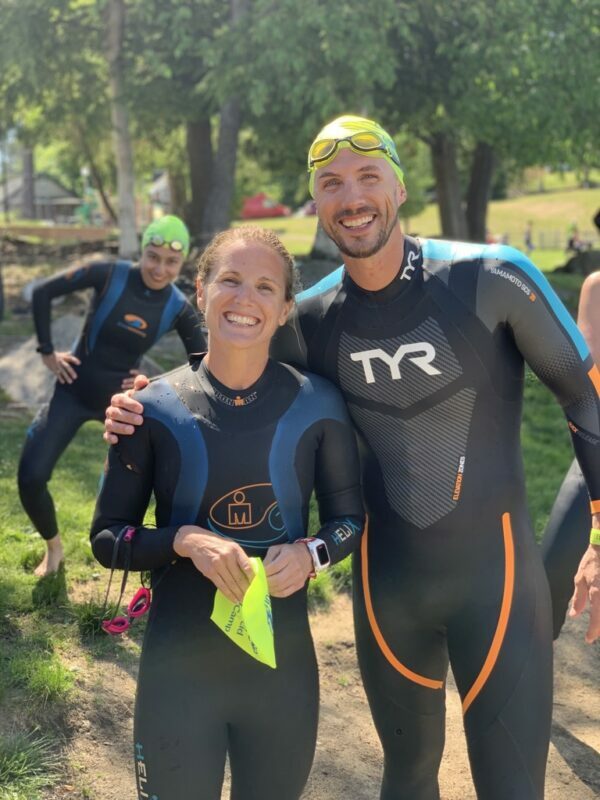Swimming does not require much gear besides a cap and goggles. However, a few key swim gear items can make you a faster, stronger swimmer, while others are not worth your money. To help you sort through what swim gear is worth it, and what isn’t, here is a complete list of legit vs sh*t swim gear.
Legit
The following list is swim gear you will want to acquire to assist you in improving swim skills and dynamics. However, with many of these tools, too much use can be too much of a good thing. So, for tools like paddles, buoys, fins, and kick boards – use them judiciously and with intention.
Goggles
Your goggles are crucial for a good field of vision to navigate around other swimmers and see the wall in the pool or buoys in open water. They’ll also protect your eyes from getting red and irritated from the chlorine. Goggle fit is about as individual as bike saddles – it depends on the shape of your face and eye sockets, so what works for one person may not work for someone else. Some reputable goggles to start with include TYR black hawk racing goggles or special ops, Speedo vanquishers, and Roka varieties.
Swim caps
Swim caps keep hair out of your face, protect the hair from chlorine’s corrosive effects, and offer hydrodynamic benefits. Generally there are two kinds of caps: silicone and latex. Silicone is more durable but slightly more expensive. Latex caps are cheap, will not last as long, but may be a little more breathable than silicone caps. Some athletes have latex allergies, so silicone is a great option.
Paddles
Paddles can help increase strength and be a good tool for encouraging correct hand placement and maintaining a high elbow. However, instead of picking the biggest paddles you can find, choose ones just slightly bigger than your hands so you increase surface area but not so much that your stroke rate decreases and your shoulders get destroyed.
Pull Buoys
Pull buoys center our focus on the pull, simulate a wetsuit swim, and make hypoxic sets or bilateral breathing a little easier by taking the oxygen sucking kick out of it. But pull buoys remove our core from the stroke, which doesn’t encourage proper stroke mechanics if we use it too much. So, like all swim toys, use it for particular sets and not for the majority of workouts.
Snorkels
Snorkels can be great tools for watching hand placement, for drill and kick work, and can also help balance the stroke if you breathe to only one side. Get one of these and keep it in your swim bag!
Kick Boards
Kick boards can be ok for beginners but once you are more comfortable with body balance and position in the water, lose the kick board and kick on your side or back or belly so you’re kicking in positions that you’re in during normal freestyle or backstroke.
Cadence Counters/Tempo Trainers
Cadence counters can be useful for finding the ideal stroke rate where you’re fastest.
Swim Band
A swim band for legs is great for finding ideal head position and dead spots in the pull. It forces you to keep your arms moving at a balanced and even rate, along with keeping your hips high and your face down, otherwise your legs will sink. Swimming with a band can increase power in your pull, increase stroke rate, reinforce the need to have a high elbow catch, and remind you to keep your head in a neutral position.
Fins
Fins can improve ankle flexibility but do not use them for all kicking sets, and don’t use them as a crutch for a weak kick. Longer fins can encourage more knee bend and a slower kick cadence while shorter fins encourage a quicker cadence which is what we want, but both types of fins are useful.
Swim Safety Buoy
Lastly, a good open water tool is a swim safety buoy, which is great for open water visibility, especially if you’re swimming alone

Sh*t:
The following swim gear list includes those we don’t recommend as being worth the expense. While there may be some limited use for these items, they are not the gear to purchase to maximize your bang for the buck.
Buoyancy Shorts
Buoyancy shorts can cause triathletes to become reliant on them. The use of these shorts will also limit kicking, and create issues with body balance. They will make you more reliant on using a wetsuit, so what happens when your race is a non-wetsuit swims?
Swim Heart Rate
Do not waste your money on heart rate monitors for swimming since you can’t view your heart rate in real time (and the goggles that show heart rate could be distracting). You are better off matching perceived effort to your split times and getting a feel for what different intensities and paces feel like.
Swim Skins
Swim skins are personal choice – they may be more restrictive, produce very marginal gains, and take too much time to take it off in T1. But if a tri suit has pockets and chamois, it may be worth wearing a skin, especially for a longer swim (half or full triathlon). The speed that you’re swimming matters – faster swimmers may save only 3 sec per 400m. And a swim skin may feel more hydrodynamic, so if you feel faster, you may swim faster. No matter what you choose, practice wearing your kit or swim skin before the race to see how they feel in the water.
Some swim gear is worth the expense – and some isn’t. Start with the basics, and keep your focus on improving swim form. Your biggest gains will come from that!
